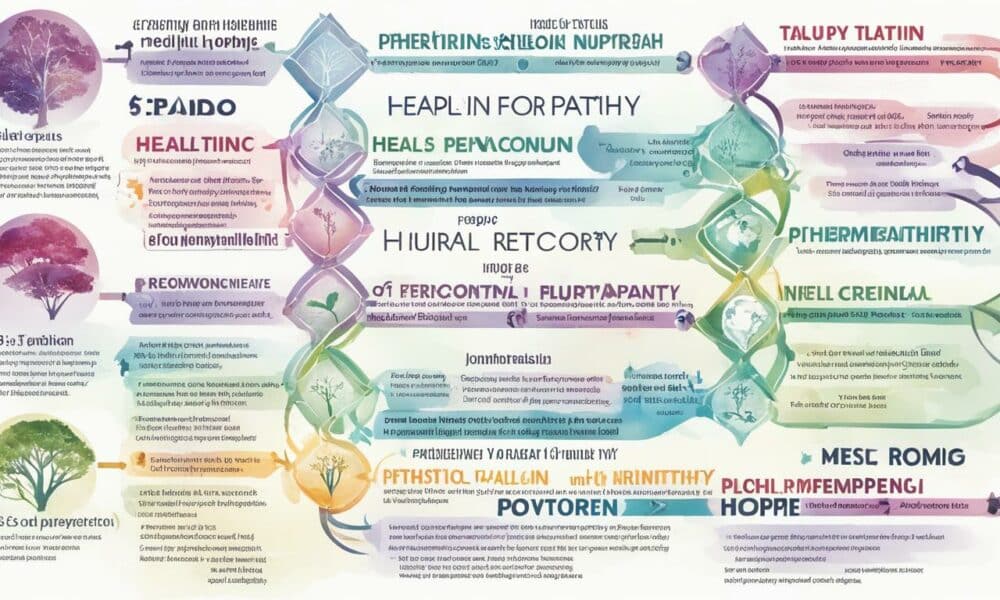
Healing Peripheral Neuropathy: Timelines & Tips
Peripheral neuropathy is a condition that affects millions of people worldwide, causing numbness, tingling, or weakness in the hands and feet. If you’re dealing with peripheral neuropathy, you’re probably wondering how long it takes to heal and what you can do to speed up the process. In this article, we’ll explore the timeline for healing peripheral neuropathy and provide you with valuable tips for a smoother recovery process.
Key Takeaways:
- Peripheral neuropathy healing time can vary depending on several factors.
- It’s essential to seek appropriate support along the way and monitor your progress regularly.
- Following the recommended treatment, adopting healthy habits, and staying positive can improve your chances of a successful recovery.
- Lifestyle changes, self-care practices, and complementary therapies may also help enhance the recovery process.
- Patience and perseverance are key during the healing process, as everyone’s journey is unique.
Understanding Peripheral Neuropathy
Peripheral neuropathy is a condition that affects the peripheral nerves, causing weakness, numbness, and pain in the hands and feet. It can also affect other parts of the body, such as the arms, legs, and face.
The causes of peripheral neuropathy vary, but some common ones include chronic diseases like diabetes or kidney problems, trauma, infections, toxic exposure, and even genetics.
The symptoms of peripheral neuropathy can also vary but commonly include tingling, burning, and numbness in the affected area. Other symptoms may include muscle weakness, sensitivity to touch, and difficulties with coordination.
Treatment options for peripheral neuropathy can range from medication, physical therapy, and changes in diet and lifestyle. It’s important to work with a healthcare provider to determine the best course of treatment for your unique situation.
| Treatment Option | Duration |
|---|---|
| Medication (e.g. pain relievers, anti-seizure drugs) | Varies based on medication, but typically several weeks to months |
| Physical therapy/exercise | Ongoing for several months to a year or more |
| Changes in diet and lifestyle (e.g. managing diabetes or reducing toxin exposure) | Ongoing as needed for managing underlying conditions |
It’s important to understand that the duration to heal peripheral neuropathy can vary based on the individual’s condition and treatment plan. With patience, commitment to treatment, and support, it’s possible to manage symptoms and improve function over time.
Factors Affecting Healing Time
Peripheral neuropathy manifests differently in each individual, and as such, there is no standard timeline for recovery. However, several factors can affect the healing period for peripheral neuropathy, including:
- The severity of the condition
- Individual differences in response to treatment
- Adherence to the recommended treatment plan
The severity of peripheral neuropathy can influence the duration required for recovery. For instance, mild cases may resolve within a few weeks, while more severe cases may take months or even years.
Similarly, individual differences can also impact the healing duration, with some individuals responding better to treatment than others. Adherence to the recommended treatment plan, including medication, physical therapy, or lifestyle changes, can also influence the recovery time.

Severity of peripheral neuropathy and recovery duration
| Severity of Peripheral Neuropathy | Recovery Duration |
|---|---|
| Mild | A few weeks |
| Moderate | 1 to 6 months |
| Severe | 6 months to several years |
In conclusion, the healing period for peripheral neuropathy is dependent on various factors, including the severity of the condition, individual differences, and adherence to treatment. With adequate treatment and follow-up, individuals with peripheral neuropathy can achieve a successful recovery.
Treatment Approaches for Peripheral Neuropathy
There are several treatment approaches for peripheral neuropathy, and the healing timeline may vary depending on the severity of the condition and the adherence to treatment. Let’s explore some of the treatment options available:
Medications
Medications may be prescribed to relieve the symptoms of peripheral neuropathy, such as pain, numbness, and tingling. Some common medications include:
- Antidepressants: These medications can help relieve pain by altering brain chemicals.
- Anticonvulsants: These medications are typically used to treat seizures but can also help with nerve pain.
- Opioids: These medications are potent painkillers that may be used for severe pain but are often only prescribed for a short period due to the risk of addiction.
Therapies
Physical therapy and other types of therapies may be recommended to help with peripheral neuropathy symptoms and improve overall function. Some potential therapies include:
- Occupational therapy: This type of therapy can help individuals relearn essential skills, such as dressing or cooking, that may have been impacted by peripheral neuropathy.
- Physical therapy: Physical therapy can help improve strength, flexibility, and balance and may also entail exercises to alleviate discomfort.
Surgery
In rare cases, surgery may be required to treat peripheral neuropathy. For instance, surgery may be needed to remove a tumor or alleviate nerve compression.

It’s essential to work closely with your healthcare provider to determine the best course of treatment based on your individual needs and circumstances.
Tips for Enhancing Recovery
Peripheral neuropathy recovery duration can be frustrating, but there are plenty of actionable steps individuals can take to improve the healing process. Here, we have compiled a list of tips and strategies that may help enhance recovery time:
A Healthy Diet
A balanced and nutrient-rich diet can help speed up the recovery process. Consider incorporating fresh fruits and vegetables, lean proteins, and healthy fats into your meals to help improve your body’s healing capabilities.
Exercise and Physical Therapy
Regular exercise and physical therapy can help strengthen weakened muscles and improve overall balance. Talk to your doctor about the best exercise regimen for your condition, and consider working with a physical therapist as well.
Complementary Therapies
Consider exploring complementary therapies such as acupuncture, massage therapy, or yoga, as they may help alleviate pain and promote relaxation. Be sure to discuss any new treatments with your doctor before trying them out.
Self-Care Practices
Daily self-care practices can help improve your overall well-being and reduce stress, which may speed up the healing process. This can include things like meditation, deep breathing, or spending time in nature.
Monitor Progress
Regularly monitoring your symptoms and progress can help you identify any setbacks and make any necessary adjustments to your treatment plan. Keep a journal or log to track your progress and share it with your healthcare provider during your appointments.
By incorporating these tips and strategies into your daily routine, you may be able to enhance your peripheral neuropathy healing time and improve your overall quality of life.
Monitoring Progress and Seeking Support
Recovery from peripheral neuropathy can be a lengthy process, and it’s essential to monitor your progress regularly. Keep track of any improvements or setbacks and share them with your doctor or healthcare team. Together, you can adjust your treatment plan to ensure the most effective healing.
If you experience any worsening of symptoms, don’t hesitate to seek medical attention. Delaying treatment can cause long-term damage, making it more difficult to recover. Your doctor may recommend additional therapies or suggest changes to your current treatment plan.
It’s also essential to seek emotional support during the healing process. Peripheral neuropathy can take a toll on your mental health, causing anxiety, depression, and frustration. Talk to close friends or family members about your experience and how you’re feeling. You may also consider joining a support group for individuals with neuropathy.
“You are not alone in your neuropathy journey, and there are many resources available to help you along the way.”
Remember, the healing timeline for peripheral neuropathy varies from person to person. Some individuals may recover quickly, while others may take months or even years. Be patient and stay positive, focusing on the progress you’re making rather than the time it takes to heal. With the right care, support, and attitude, you can overcome peripheral neuropathy and regain your quality of life.
Conclusion
In conclusion, healing from peripheral neuropathy can be a long and challenging journey, but it’s achievable with proper care and support. As discussed in this article, multiple factors can impact the recovery process, including the severity of the condition, treatment adherence, and individual differences.
However, by understanding the condition, following the recommended treatment, adopting healthy habits, and seeking support, individuals can improve their chances of a successful recovery.
It’s crucial to monitor progress regularly, celebrate small victories, and remain patient when setbacks occur. Remember, everyone’s journey is unique, and it’s okay to ask for help when needed.
With time and effort, it’s possible to recover from peripheral neuropathy and regain a better quality of life. Keep a positive attitude and stay committed to your recovery goals, and you’ll soon see the light at the end of the tunnel.
FAQ
How long does peripheral neuropathy take to heal?
The healing time for peripheral neuropathy varies depending on several factors, including the underlying cause, severity of the condition, and individual differences. In some cases, it may take several months to a few years for complete healing to occur.
What is the duration to heal peripheral neuropathy?
The duration to heal peripheral neuropathy varies from person to person. While some individuals may experience improvements within a few months, others may require a longer recovery period. It’s important to consult with a healthcare professional for an accurate assessment of your specific situation.
How long does it take to recover from peripheral neuropathy?
The recovery period for peripheral neuropathy can range from several months to years. The healing process depends on various factors, including the underlying cause, the effectiveness of treatment, and individual factors such as overall health and lifestyle habits.
What is the healing period for peripheral neuropathy?
The healing period for peripheral neuropathy can vary significantly. It depends on the severity of the nerve damage, the treatment approach, and the individual’s response to treatment. It’s important to follow the recommended treatment plan and regularly communicate with your healthcare provider to monitor progress and adjust treatment if necessary.
What is the time frame for healing peripheral neuropathy?
The time frame for healing peripheral neuropathy can vary. Some individuals may experience improvements in symptoms within a few weeks or months, while others may require a longer time frame. It’s crucial to have realistic expectations and work closely with your healthcare provider to monitor progress and adjust treatment as needed.











